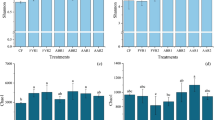Abstract
Fourteen species of wild growing mushrooms and surface (0–10 cm) soils were collected near Lake Wdzydze in the northern part of Poland in 1996–1997 to understand the status of mercury pollution. Concentrations of mercury in mushrooms varied between 100±30 and 2400±1900 ng g-1 dry matter in caps and 60±1 and 1300±1500 ng g-1 dry matter in stalks. Concentrations of mercury in underlying soil were between 30±1 and 140±120 ng g-1 dry matter (between 36±18 and 63±100 ng g-1 depending on the soil type). Bioconcentration factors (BCF: concentrations in mushroom/concentrationin soil) of total mercury were between 2.3±1.1 and 90±110 for caps, and between 2.1±1.0 and 53±56 for stalks. Scaly tooth (Sarcodon imbricatum) contained the greatest concentrations of mercury in the flesh. However, there was no significant relationship (p >: 0.05) between mercury content in the fruiting bodies of this speciesto soil mercury concentrations. A significant (p < 0.01) positive relationship between mercury content in caps to underlying soil was noted for European cow bolete (Suillus bovinus), while a negative relationship between mercury content in caps and stalks to underlying soil was observed for Sandy knight-cap (Tricholomaflavovirens), Shaggy scale-head (Pholiota squaroso-adiposa),Gypsy mushroom (Rozites caperata) and Pine spike cap (Chroogomphus rutilus).
Similar content being viewed by others
References
Alonso, J., Salgado, M. J., Garcia, M. A. and Melgar, M. J.: 2000, ‘Accumulation of mercury in edible macrofungi: Influence of some factors’, Arch. Environ. Contam. Toxicol. 38, 158-162.
Bakken, L. R. and Olsen, R. A.: 1990, ‘Accumulation of radiocaesium in fungi’, Can. J. Microbiol. 36, 704-710.
Byrne, A. R., Ravnik, V. and Kosta, L.: 1976, ‘Trace element concentrations in higher fungi’, Sci. Total Environ. 6, 65-71.
Dziennik Ustaw: 2000, No. 9, 27 December, position 72.
Falandysz, J.: 1990, ‘Mercury content of squid Loligo opalescens’, Food Chem. 38, 171-177.
Falandysz, J.: 2002, ‘Mercury in mushrooms and soil of the Tarnobrzeska Plain, southeastern Poland’ J. Environ. Sci. Health A37, 343-352.
Falandysz, J. and Bielawski, L.: 2001, ‘Mercury content of wild edible mushrooms collected near the town of Augustów’, Pol. J. Environ. Stud. 10, 67-71.
Falandysz, J. and Chwir, A.: 1997, ‘The concentrations and bioconcentration factors of mercury in mushrooms from the Mierzeja Wislana sand-bar, Northern Poland’, Sci. Total Environ. 203, 221-228.
Falandysz, J., Gucia, M., Kawano, M., Brzostowski, A. and Chudzynski, K.: 2002, ‘Mercury in mushrooms and soil from theWielunska Upland in South-central Poland’, J. Environ. Sci. Health A37, 1409-1420.
Falandysz, J., Marcinowicz, A., Danisiewicz, D. and Galecka, K.: 1997, ‘Mercury in mushroom and underlying substrate in area udjacent to Lubiana, County of Koscierzyna’, Bromat. Chem. Toksykol. 30, 63-68 (in Polish).
Falandysz, J., Swieczkowski, A. and Danisiewicz, D.: 1999, ‘Mercury content of wild edible mushrooms from the area of Wdzydze Landscape Park’, Bromat. Chem. Toksykol. 32, 201-205 (in Polish).
Falandysz, J., Szymczyk, K., Ichihashi, H., Bielawski, L., Gucia, M., Frankowska, A. and Yamasaki, S.: 2001, ‘ICP/MS and ICP/AES elemental analysis (38 elements) of edible wild mushrooms growing in Poland’, Food Addit. Contam. 18, 503-513.
Fischer, R. G., Rapsomanikis, S., Andreae, M. O. and Baldini, F.: 1995, ‘Bioaccumulation of methylmercury and transformation of inorganic mercury by macrofungi’, Environ. Sci. Technol. 29, 993-999.
Jedrzejczak, R.: 2000, Studies on Mercury end Selenium Contents in Food of Plant Origin Including Validation Methods of Analysis, Dissertations and Monographs 30, University of Warmia and Mazury, Olsztyn, ISBN 83-88343-75-0 (in Polish).
Kalac, P., Burda, J. and Stašková, I.: 1991, ‘Concentrations of lead, cadmium, mercury and copper in mushrooms in the vicinity of a lead smelter’, Sci. Total Environ. 105, 10-19.
Kalac, P., Nižnanská, M., Bevilaqua, D. and Stašková, I.: 1996, ‘Concentrations of mercury, copper, cadmium and lead in fruiting bodies of edible mushrooms in the vicinity of a mercury smelter and a copper smelter’ Sci. Total Environ. 177, 25-28.
Kalac, P. and Svoboda, P.: 2000, ‘Review of trace element content in edible mushrooms’, Food Chem. 69, 273-281.
Kannan, K. and Falandysz, J.: 1998, ‘Speciation and concentrations of mercury in certain coastal marine sediments’, Water, Air, and Soil Pollut. 103, 129-136.
Kannan, K., Smith, R. G., Lee, R. F., Windom, H. L., Heitmuller, P. T., Macauley, J. M. and Summers, J. K.: 1998, ‘Distribution of total mercury and methyl mercury in water, sediment and fish from South Florida estuaries’, Arch. Environ. Contam. Toxicol. 34, 109-118.
Laaksovirta, K. and Lodenius, M.: 1979, ‘Mercury concentration of fungi in Helsinki’, Ann. Bot. Fennici 16, 208-212.
Lodenius, M. and Herranen, M.: 1981, ‘Influence of a chlor-alkali plant on the mercury contents of fungi’, Chemosphere 10, 313-318.
Mietelski, J. W., Larosa, J. and Ghods, A.: 1993, ‘90Sr and 239+240Pu, 238Pu, 241Am in some samples of mushrooms and forest soil from Poland’, J. Radioanal. Nucl. Chem. 170, 243-258.
Quinche, J.-P.: 1976, ‘Mercury contamination of various species of the genus Agaricus’, Reuv. Suisse Agric. 8, 143-148 (in French).
Rauter, W.: 1975, ‘Pilze als Indikatoren für Quecksilberimmission am Standort einer Chlor-Alkali-Electrolyse’, Zeitsschrift fur Lebensmittel Untersuchung und Forschung 159, 149-151.
Slekovec, M. and Irgolic, K. J.: 1996, ‘Uptake of arsenic by mushrooms from soil’, Chem. Spec. Bioavailab. 8, 67-73.
U.S. EPA: 1989, Health Effects Assessment, Office of Emerging and Remedial Response, U.S. Environmental Protection Agency, Washington, D.C.
Wondratschek, I. and Röder, U.: 1993, ‘Monitoring of Heavy Metals in Soils by Higher Fungi’, in B. Markert (ed.), Plants as Biomonitors, VCH Verlagsgesellschaft, Weinheim, pp. 345-363.
Author information
Authors and Affiliations
Corresponding author
Rights and permissions
About this article
Cite this article
Falandysz, J., Brzostowski, A., Kawano, M. et al. Concentrations of Mercury in Wild Growing Higher Fungi and underlying Substrate near Lake Wdzydze, Poland. Water, Air, & Soil Pollution 148, 127–137 (2003). https://doi.org/10.1023/A:1025422017868
Published:
Issue Date:
DOI: https://doi.org/10.1023/A:1025422017868




